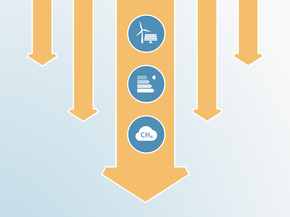Country summary
Overview
The Gambia is one of the rare developing countries in the world to propose an ambitious conditional target that would bend its emissions onto a downward trajectory. The unconditional target is also amongst the most ambitious: the CAT rates this commitment “1.5°C Paris Agreement compatible.”
In its Nationally Determined Contribution (NDC), the Gambia offers to conditionally reduce its greenhouse gas emissions, excluding the land use, land use change and forestry (LULUCF) sector, by 1.4 MtCO2e in 2025 compared to business-as-usual (BAU). This is equivalent to a 44.4% reduction below a “low BAU” scenario excluding LULUCF in 2025. The Gambia is offering to reduce emissions by 0.08 MtCO2e in 2025 (or 2.4%) below BAU unconditionally; the additional emission reductions are conditional on international finance and technical support.
In addition to the emission reduction targets for 2025, The Gambia’s NDC submission also mentions its emission reduction ambition for 2030, namely to unconditionally reduce emissions by 0.10 MtCO2e (or 2.7%) below BAU excluding LULUCF and to conditionally reduce emissions by 1.8 MtCO2e (or 45.4%) below BAU excluding LULUCF.
The Gambia’s NDC also includes abatement in the LULUCF and agriculture sectors: it plans to unconditionally abate 0.28 MtCO2e by 2025 and 0.33 MtCO2e by 2030 through afforestation as well as 0.69 MtCO2e in 2025 and 0.67 MtCO2e in 2030 by replacing flooded rice fields by dry upland ones, and by using efficient cook stoves to reduce the overuse of forest resources, conditional on international support.
The CAT rates (I)NDCs only on unconditional targets excl. LULUCF. The Gambia submitted its unconditional pledge with a 2025 emissions reduction commitment. The CAT assesses The Gambia’s 2025 NDC based on this pledge for 2025 and rates the NDC commitment “1.5°C Paris Agreement compatible.” The “1.5°C Paris Agreement compatible” rating indicates that The Gambia’s climate commitment in 2025 is consistent with holding warming well below 2oC, and limiting warming to 1.5°C. The Gambia’s commitment does not require other countries to make comparably deeper reductions or greater effort, and is in the most stringent part of its Fair Share range. If the CAT were to rate the NDC based on The Gambia’s indicated 2030 emission reduction targets, the NDC would also be rated “1.5°C Paris Agreement compatible”.
The government has recognised that the transition to an affordable sustainable energy system is a critical milestone for the country’s socio-economic development as dependence on imported fuel oil has become a burden on the Gambian economy (IRENA, 2013). To ignite this transition, in 2013 the government enacted the New Renewable Energy law to implement a feed-in tariff for renewable energy sources, and to establish a renewable energy fund to promote the use of such sources (Government of The Gambia, 2013). Due to a lack of recent information, some uncertainty exists about the current implementation status of this legislation (REN21, 2017).
To meet its conditional target and give confidence to international investors, the Gambian government announced, in its Sustainable Energy Action Plan (Government of The Gambia, 2015), specific renewable energy and energy efficiency targets for 2020 and 2030, and declared the measures it would deploy to reach those targets. Since these measures will be implemented only if The Gambia receives international funds and technical support, we do not include them in the current policy projections. Nevertheless, these measures set the stage for a potentially rapid implementation of its conditional NDC given that international financial resources are mobilised.
Further analysis
Latest publications
Stay informed
Subscribe to our newsletter




